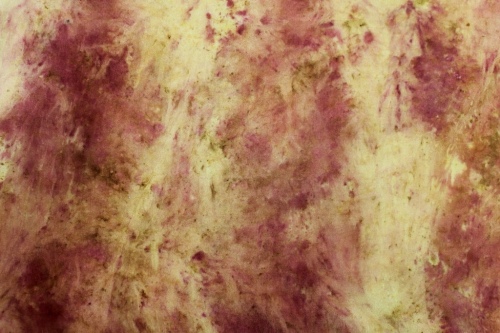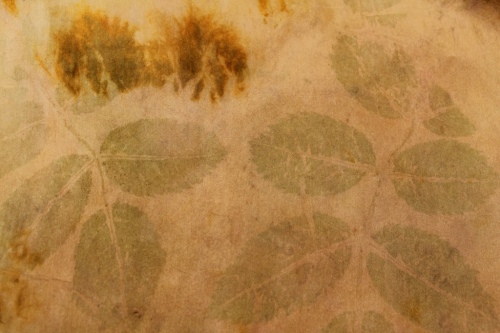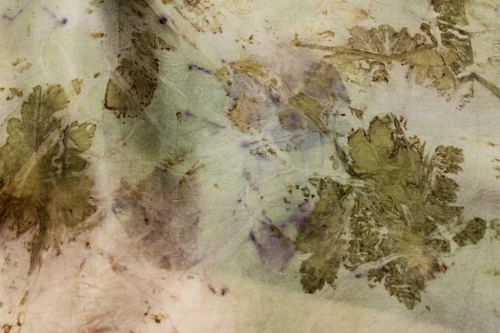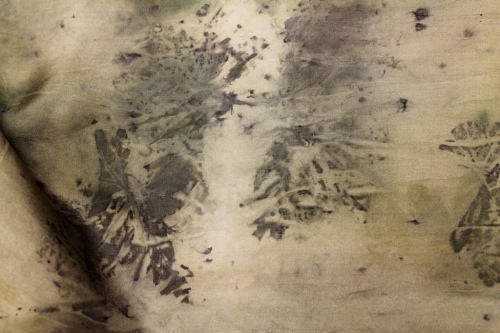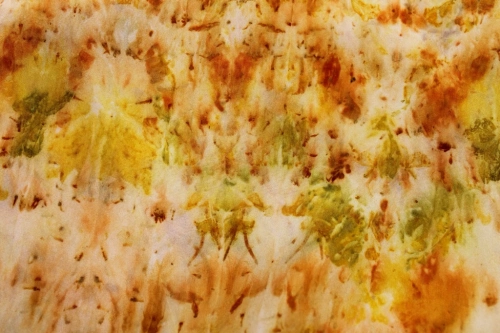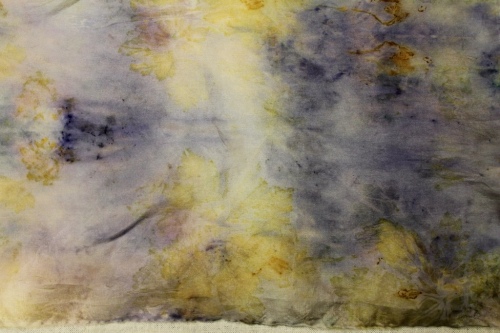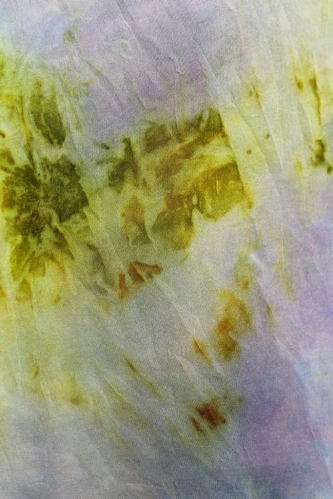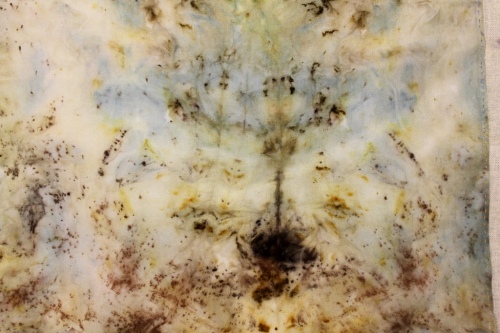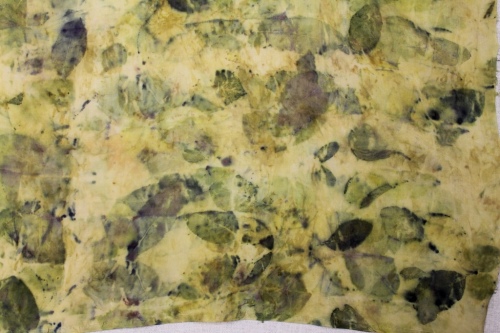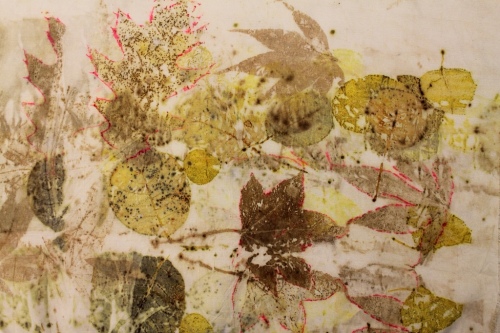Eco dyeing and printing are seasonal activities for me, closely tied to my garden's rhythms. Late summer and early fall in AgCan/USDA zones 4/5 is a period rich in accumulated plant pigments. Even though eco printing as a technique relies on the knowledge of tradional dyeing, it does not always turn up the same pigments in the dye pot as do the traditional “whole cloth, dye bath” techniques for dyeing fibres.
Furthermore, due to the nature of the eco print processes ( bundling, stacking, steaming, composting, tying, solarizing, etc.) , more than one colour may show up from one plant on a dye printed surface. This happens when the eco print processes force pigments in the plants to separate out into constituent colours on the surface of the substrate. These colour differences can often lost be when the plants are processed to extract colours by first heating them in water in a pot to make a dye bath, then processing the fibres in the dye bath to take up the colour.
I like to approach my print surfaces as if they were abstract compostions; thus, I am concerned with the interplay among colours, forms and field. The second image (rather far below) shows silk crepe de chine eco printed with a selection of native plants from my garden last week: a background lightly coloured pale- ish yellow by just a tad of goldenrod ( a few sprigs removed from the tops), a lot of coreopsis verticillata (the whole plant in bits) to give small, varied and strong red-orange marks, the blue-black berries of Aronia melanocarpa ( black chokeberry) smooshed on to contribute blue, purple and lavender areas to the field (plus the darks and lights of analagous colours, as does the coreopsis), purple sandcherry leaves for deep teal greens (not shown), and on the right, a Virginia creeper (Parthenocissus quiquefolia) leaflet in its red fall colours – but scarcely any eco print from it.
This image right below shows coreopsis (red and oranges) and red cabbage (blues) on silk. The colours and distribution of forms across the field of the textile reminded me of flower paintings by Seurat and Odilon Redon- along with the orange-blue Impressionist fave colour combos. Playing with the dye outcomes is for me the most fascinating part of contact printing with plants
Back to the Virginia creeper (VC)
VC, a native vine, is not much used in the traditional dye pot, as far as I can tell. It seems to be a kind of Bait and Switch plant, flaunting spectacular red and purple fall foliage, adorned with rich bunches of black berries that birds devour; but it appears to be a Tame, Timid and Stripeless Tiger in the trad dye pot. Adrosko, Cannon, Casselman and Dean (to mention some Big Trad Dye Names, see my References page) make no mention of VC as a dye plant. Other sources do mention it but without enthusiasm: Richards and Tyrl in their book on on North American dye plants have it classified in their chapter about plants that give little or no colour, noting only a pale yellow-cream. ( I guess that is the chapter every poor dye plant dreads to be consigned to… But take heart, Virginia creepers. Eco printing is your friend.)
Daniel Moerman (in “Native American Ethnobotany” ) writes with erudition that the Kiowa Indian tribe (in Canadian usage: “First Nations” or Kiowa native peoples) obtained pink dyes from VC berries to colour feathers used in war dances.
The notion of long-term “fastness” is not generallly addressed, other than to recommend the use of the Usual Suspects as mordants. I suspect tannins and iron might help VC colour up in an eco print process more than in the trad dye pot.
The only really hopeful discussion about potential eco print colour from the VC appears in a 1986 publication entitled “Dye Plants of Ontario” from the Burr House Spinners and Weavers Guild ( see Reference page). The guild tested the vine for dye potential, using the whole plant, having gathered it in November and noting: “This vine is not known as a dye plant.”
With alum as mordant , a 6:1 plant-to-water ratio and 45 minutes in a simmering dye bath, the colour given is “butterscotch”. Other mordants were as follows: with copper, a rich tan; with iron, a golden tan. As a modifier post-dye bath, iron gave deep bronze; ammonia, a bright golden tan. Summer foliage gave ivory with an ammonia rinse, and olive greens with a vinegar rinse. No longer recommended as mordants are tin and chrome though the Burr House dyers did report their experiments with these.
Thus, with this info In mind, I plan to experiment further with the Virginia creeper as it matures in my garden and in the environs.
And after all that “learned” text above, I expect, Dear Reader, that you will be wondering when your author will finally put up the Eye Candy.
Here it is:
The red leaf on the right is one leaflet of the five leaflets ( the “quinque” in quinquefolia) of the Virginia creeper. But hardly any eco print at all. The reds and purples came from coreopsis and aronia berries, though of course, one could be forgiven for hoping the VC had printed thus. But we know that what we see in a leaf is not what we necessarily get on an eco printed substrate. (And I think snails ate the holes in the VC leaflet – the vine was covered in snails. )
Next, I will mess around with tannins and iron to see if an eco print can be coaxed out of the Virginia creeper. There were no iron bits, bark or tannin rich plants in the bundle shown here. Of course, I am just guessing that we could get a print from the VC in the environment of these mordants/dye assistants. TBD.
Inspiration for this post
Thanks to the edltor of the Journal for Weavers, Spinners and Dyers who asked me about fastness of dye in the Virginia creeper. That question became my research topic for today, and led me down this most interesting rabbit hole. I have been planting lots of the native Virginia creeper this summer to attract birds, to give fall colour, to cover the tattier parts of our fence and to give privacy. Perhaps VC leaves can make an interesting eco print, or perhaps the VC berries can dye some war dance feathers pink (gonna try for those pink feathers for sure but maybe will weave them into the garden loom instead of my hair. Turn swords to ploughshares, kind of.)
Meanwhile, here is a taste of some more Eye Candy in relation to future posts about dyeing with native plants. The next post will be about eco prints on silk with other native plants from my garden. See if you can guess the plants printed here:
Hints: Walnut, coreopsis, sumac, aronia berries, rose, cotinus, goldenrod, purple sandcherry.
Until next time
Wendy
































